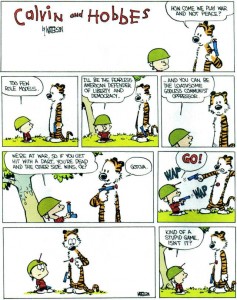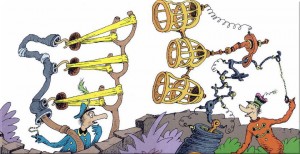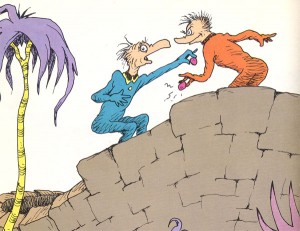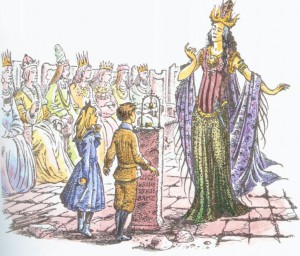An interesting historical question to ask: what was the point of the Cold War, and did it accomplish anything?
Some postulate that the Cold War was about the Allies halting the spread of communism, while others might say that it was a consequence from the political fallout after World War II (once Hitler was gone, our Soviet ally, Stalin, became the new enemy). Basically, it was a clash of cultures – republican capitalism on one side, oligarchic communism on the other. Since neither would tolerate the other’s existence in the short or long term, the race to outdo and/or destroy the other side began. Cartoonist Bill Watterson used Calvin and Hobbes to show the mentality of the Cold War and the ultimate end if it ever turned “hot”:
Author Ted Geisel (Dr. Seuss) found an interesting way to present this conflict in his controversial (for its time) book, “The Butter Battle.” He portrays a mirrored conflict between opposing worldviews in the Yooks and Zooks, who eat their bread with the butter side up or down, respectively.
When a small shot is fired, each side works to construct bigger, more powerful weapons to promote their side’s agenda; eventually, they manufacture the ultimate weapon – the Bitsy Big-Boy Boomeroo, a grape-sized mixture of chemicals emblematic of the nuclear bomb. The story ends with the then-state of affairs of stalemate – which, in essence, is the logical conclusion – unless one or both sides choose to actually unleash the weapon of ultimate destruction.
Interestingly, C.S. Lewis speculated about such an event in his sixth book about Narnia, “The Magician’s Nephew.” Remember Jadis (the White Witch) from “The Lion, the Witch, and the Waredrobe?”
In his sixth book, C.S. Lewis takes a step back and tells the backstory of how Jadis came to be in Narnia. Digory Kirke (the Professor from LWW) finds out that his uncle is a magician and has rings that can take people into other worlds. In an old, dying world named Charn, he and his friend Polly encounter Jadis. She recounts how Charn was shattered by a civil war between herself and her sister; Jadis used a doomsday weapon – the Deplorable Word, which destroyed all life except the one who spoke it. Digory and Polly accidentally bring Jadis back to our world, then into Narnia when it is being made. It is there – thanks to another fateful choice on her part – that she becomes the White Witch.
At the very end of the book, after Aslan has taken measures to protect Narnia for a while, he takes Digory and Polly back to our world, but not before warning them about how worlds can come to a terrible end.
“They looked and saw a little hollow in the grass, with a grassy bottom, warm and dry.
‘When you were last here,’ said Aslan, ‘that hollow was a pool, and when you jumped into it you came to the world where a dying sun shone over the ruins of Charn. There is no pool now. That world is ended, as if it had never been. Let the race of Adam and Eve take warning.’
‘Yes, Aslan,’ said both the children. But Polly added, ‘But we’re not quite as bad as that world, are we?”
“Not yet, Daughter of Eve, not yet; but you are growing more like it. It is not certain that some wicked one of your race will not find out a secret as evil as the Deplorable Word and use it to destroy all living things. And soon, very soon, before you are an old man and an old woman, great nations in your world will be ruled by tyrants who care no more for joy and justice and mercy than the Empress Jadis. Let your world beware.”



